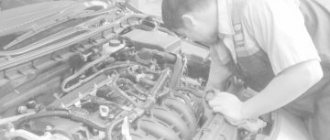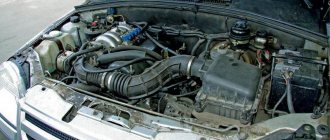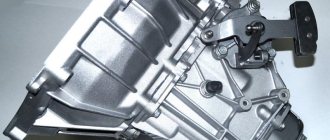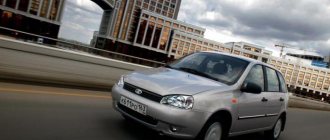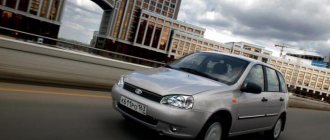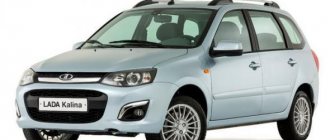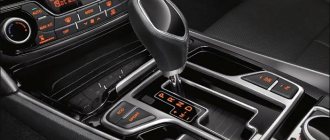From the very beginning of sales, AVTOVAZ has been installing a modified VAZ 2182 automated transmission (AMT with version 2.0) on the updated Lada Granta family. “Robot” received a number of improvements and new operating modes, which had a positive impact on user ratings. The article presents reviews from auto experts and owners of these cars.
Lada Granta AMT - review
Details Category: Test drive Published 11/05/2015
Today I want to share my review after a test drive of a Lada Grant with an AMT - robotic gearbox.
AMT is an automated transmission, one of the latest innovations from AVTOVAZ. Behind this abbreviation lies an ordinary robotic gearbox, which is successfully used by many manufacturers. Unlike modern transmissions such as DSG or PowerShift, the AMT from AVTOVAZ has only one clutch, not two. This is a simple and cheap solution, popular in the budget segment. “Robots” with one clutch were installed on some models of Peugeot, Renault, Toyota, etc.
What is the difference between the Lada Granta AMT and the regular Granta? Outwardly - nothing. In the cabin - the presence of an AMT selector instead of the usual gearshift lever, as well as the absence of a clutch pedal.
Under the hood of the Lada Grant AMT there is a conventional five-speed manual transmission VAZ-2180. It differs only in the absence of a traditional clutch release drive and gear selection mechanism. Instead, electric drives from the German company ZF are installed, which perform the driver’s work of disengaging/engaging the clutch and shifting gears. Also additionally installed are a gearbox input shaft speed sensor and a separate electronic transmission control unit.
That's enough theory, it's time to get behind the wheel. The gear selector has a neutral, forward, reverse, and manual mode. Unlike a traditional automatic, the AMT does not have a “Parking” mode; the car must be left in neutral when parked or turned off while the gear is engaged. This is one of the disadvantages of the Lada Granta with AMT - in winter, after washing the car, in order to avoid freezing of the pads, you will have to leave it with the gear engaged and without a handbrake, which will not allow you to use the automatic engine start.
Another disadvantage of AMT on the Lada Granta is maneuvering in a parking lot. The fact is that when the brake is released, the car does not start moving, like a classic automatic. In order for the car to move, you need to increase the speed of the gas pedal. Sometimes this causes shocks when maneuvering forward and backward in a parking lot - you need to get used to it.
Now about the driving features of the Lada Grant with AMT . Having turned on the forward driving mode, you need to smoothly press the gas for the car to move. When driving, gear changes are not very fast, there is a second pause. However, if you slightly release the gas pedal at the moment of switching, the switching occurs smoothly and quickly. That is, you can’t just stupidly press the gas and accelerate, like with a regular automatic transmission. In this mode, the “robot” switches with noticeable jerks and delays. However, you quickly get used to it and intuitively begin to release the gas pedal at the moment of switching.
But if you press the gas sharply and to the floor, the AMT holds the selected gear almost until the red zone of the tachometer, which is convenient when overtaking on the highway.
For those who are especially sophisticated, there is a manual switching mode. By switching the selector to manual mode, the driver selects the gear himself. At the same time, in the selected gear, the engine spins almost to the cutoff until the driver engages an overdrive gear. But the AMT switches to lower gears when braking on its own, which prevents the engine from stalling and allows engine braking, saving fuel. One minus is that the manual mode control here is not like other cars, but exactly the opposite - moving the lever forward engages an upshift, and moving the lever backwards engages a downshift. Again, it takes some getting used to.
But in general, the Lada Granta with AMT behaves on the road much more comfortably and dynamically, even the same Renault Sandero with the Easy'R “robot”. Perhaps the difference in the engine has an effect - the Lada has a top-end engine with a capacity of 106 hp, while the Renault has the weakest engine available. There may also be a difference in the settings of the transmission “brains”.
The most important advantage of the “robot” is the price. For example, on Grant the surcharge for AMT is half that for a 4-speed automatic transmission from Jatco. At the same time, the driver, in fact, gets two gearboxes in one - if you want, drive an automatic transmission, or if you want, click the gears manually.
What has been improved in AMT
The AMT upgrades of the new Granta are similar to those on the Lada Vesta with 1.8-liter engines:
- The main gear ratio has been increased from 3.710 to 3.940. This means increased fuel consumption, reduced noise and vibration levels in the transmission, and more dynamic acceleration.
- New AMT operating modes have appeared: creeping, sports and winter.
- AMT gear shift time has been reduced by almost a third.
- In the AMT clutch, the driven disc has increased heat resistance and the friction linings have become thicker, which, coupled with new algorithms, makes field driving more confident.
Why was a robot needed at all?
AvtoVAZ strives to be in trend and follows global trends. This was the answer to this question from the company's management at all major press conferences. But in fact, everyone understands that Lada developed its “own” robot far from wanting to be in trend. The company created a gearbox that would replace the Japanese Aisin automatic, which turned out to be too expensive after the ruble exchange rate jumped. This is a banal saving, which today leads to increased costs of money on the part of car buyers.
There are several real factors that influenced the appearance of the robot as a whole:
- an increase in the price of the machine gun, since the company bought it in dollars and installed it on assembled cars; the Japanese assembled the machine guns and ensured a very high quality of their design;
- the four-speed automatic no longer looked modern, something more relevant, dynamic and fashionable was needed, which was the solution for the robot with its interesting design;
- it was necessary to come up with something Russian so that domestic cars would become more their own, less dependent on currency fluctuations and other unpleasant economic effects;
- this way the company concentrated more financial flows in its hands, was able to invest more money in its own developments and benefit financially in the end from all innovations;
- it is necessary to somehow improve the image of the corporation, and the new development came in handy to improve the perception of AvtoVAZ on the Russian market, as well as to enter the markets of other countries.
These are the multifaceted reasons for the introduction of this new product, from which ordinary buyers did not benefit, but the plant benefited. Of course, it would be better to have an Aisin automatic under the hood, which will last longer than the domestic engine. But Lada is still promoting its own development, which costs much less. Therefore, there is no point in hoping for major improvements in technology in the near future. You'll have to get used to the robot or just take the mechanics and not know grief with it.
We invite you to watch a video review of the features of the machine with robot 2.0:
Test drive Grants with a robot: race results
Lada granta liftback
According to the control principle, the new gearbox is not inferior to the simplicity of automation. The movement begins by pressing the brake and moving the selector to neutral. This system allows you to secure the start of the car, thereby preventing errors when working with the new product. Driving a robotic Granta will be more familiar to previous owners of cars with an automatic transmission.
The conducted races were able to show how easy the model is to control: it accurately responds to switching, but exhibits a slight delay when starting. Short signal transmission is not critical.
For many motorists, this feature will not be a problem to purchase. But before purchasing, you need an independent test drive to evaluate the ease of operation.
The tests carried out by the developers themselves made it possible to evaluate the efficiency of the car. According to the race data, the average for city driving in “manual” mode is 6.1 liters per 100 km, and on the highway it drops to 5.1 liters.
Full automatic, suitable mainly for novice drivers, leads to different results: city consumption of 8.1 liters. Therefore, the use of manual switching is more beneficial for any owner of the updated Grant.
Experts, having carried out a test drive for the Lada Grant with a robot, noted the smooth running of the model itself. Unlike the performance of the robotic Priora, the Granta has greater attractiveness and accuracy.
Thanks to the updated frame and additions to the system, trips are made without problems. And the control is done softly: jerks during movement and long pauses when changing gears are eliminated.
On what machines does it occur?
Before talking about the pros and cons of power shift, we suggest that you familiarize yourself with the list of 2022 models on which this transmission is found:
- The Ford EcoSport power shift crossover can be found on versions with front-wheel drive and a 1.6 liter gasoline engine with 122 hp;
- Ford Fiesta (sedan and hatchback) is equipped with a robot paired with front-wheel drive and a 1.6-liter engine with a capacity of 105 and 120 horsepower;
- Ford Focus (sedan, hatchback and station wagon) PowerShift gearbox is installed on front-wheel drive versions with a 1.6-liter engine with a power of 105 and 125 hp.
As you may have noticed, the robotic transmission is paired with front-wheel drive versions and a 1.6 petrol engine.
A few words about the car interior
The seats are not luxury, of course, but they are comfortable to sit in, oddly enough, and there is an adjustment - you can adjust them to suit you, but only back and forth, raise them higher so that you can’t see the front. Seat with leather inserts.
What’s bad is that there is no noticeable lateral support, no lumbar support adjustment, the back is curved back. Although this is all corrected with special covers. I was very happy when I found out that there are heated seats. But then I encountered a pitfall - the heating of the xray chair will not work until it feels the weight of your body, that is, until you plop down on the seat.
You'll have to sit on ice and no one will care that it's freezing outside and you're freezing. But after about three minutes you feel a pleasant warmth under your heel, your back is also warming up. Cool stuff. It heats up to a certain point, turns off, and when the temperature drops, it turns on again. That is, it maintains heat all the time. The heating button, however, is located in such a way that without half a liter for the first time, you can’t find it by touch - on the left, between the seat and the door.
Related articles: Disadvantages that we don’t know about: reviews from Lada Xray owners
It would be better if they did it on the instrument panel. But if you get used to it, your finger will intuitively fall on it.
What is inconvenient is that the steering wheel is not adjustable for reach, only up and down. On a good road, the steering is obedient and straight at speed; it doesn’t drag the car along the highway. Once the surface deteriorates a little, you constantly have to adjust the trajectory on a straight line; in turns, it forces you to work - the steering wheel is too heavy, and after turning to zero it returns with a delay, as if it had fallen asleep.
The vibration of the steering wheel caused by unevenness under lateral loads confuses me.
The engines are fire, the rest is more complicated. Is it worth buying a used Lada Granta?
People buy Lada Granta “because it’s cheap” and “but it’s new.” What if we remove the second argument? What surprises can you expect from the most affordable Lada model in used condition?
Article on the topic: Reviews from owners of the Nissan Almera Classic 2007
Data
- Granta was created on the basis of the Kalina model; it was initially announced as a separate low-cost model, replacing both the obsolete Lada with a classic layout and the front-wheel drive Samara. Granta from the Kalina sedan is distinguished by an increased rear overhang, as well as a modified design of the front and rear parts of the body. It also has a different interior.
- The sedan has been produced since 2011, the liftback - since 2014, and the production of the latter was launched at, but in 2018 it was moved to Tolyatti. And until 2022, the Lada Sport division produced a “charged” version of the Granta Sport, boosted to 116 hp. engine, lowered suspension and rear disc brakes.
- In 2018, Granta received an update, including restyling in the style of Vesta, as well as a replenishment of the model range: the family included a hatchback and a station wagon, previously sold under the name Kalina. Now all four body types are Granta. In any case, from a technical point of view, both families are very close, so almost everything said about Granta is also true in relation to Kalina. And also to the “clones” of Datsun on-Do and mi-Do.
- In 2012, Autoreview conducted a crash test of Granta using the ARCAP method. The car, equipped as standard with one airbag, earned 8.4 points and two stars - and stood on par with such models as the Hyundai Accent (8.9 points), Chevrolet Lanos (8.1 points) and Fiat Albea (7. 5 points). In 2016, Granta Lux with two airbags and seat belt pretensioners took part in the tests. And she earned 10.7 points and three stars.
Design and operating principle of AMT
In general terms, AMT is a conventional manual transmission in which two special actuators (servo drives) are responsible for clutch operation and gear shifting. Each actuator installed on the gearbox is an electric motor with a gearbox and an actuator. The entire system is controlled by an electronic unit that selects and engages the required gear.
New LADA Granta on robot
The electronic unit takes into account the vehicle speed and engine operating mode, as well as information received from systems that monitor traffic safety (ABS, BAS, EBD, etc.). Evaluating and analyzing all the information received, the electronics unit issues a command to change gear.
After receiving the corresponding signal, the clutch is depressed using one servo drive, and the second one at this time engages the desired gear. Then the first servo smoothly releases the clutch.
Market
With the exception of the most extreme price offers, prices for Granta range from $3000-7000. At the same time, the year of manufacture is not as important as the declared mileage and condition. Still, many cars work in taxis or as service acceleration vehicles, while some private owners can use them as before “Lada”: rare trips and garage storage mean minimal mileage and good condition. And there are such options on the market. These are usually set at the top level.
It is also interesting that more than half of the proposals are for restyling. Aged specimens are generally not so numerous. There are equal numbers of sedans and liftbacks, restyled station wagons and hatchbacks are a drop in the ocean. The same can be said about rich configurations and 16-valve engines: both are rare. And the chances of finding an option with an “automatic” or “robot” are minimal; almost all cars have a manual transmission.
Article on the topic: Nissan Qashqai 2012 owner reviews
Advantages and disadvantages of AMT
Among the many advantages of the “robot” are:
Fuel consumption in a car with an installed robot depends on driving style and is 6...6.5 l/100 km in mixed mode, which allows saving up to 30% of fuel compared to a sedan or liftback LADA Granta AUTOMAT and up to 10% compared to cars , equipped with conventional “mechanics”.
AMT is based on a manual gearbox, which is much less susceptible to breakdowns than an automatic transmission. In addition, the optimal operating modes of the robot are determined electronically (there is no “human factor”), which significantly increases the service life of the engine. Repairing an AMT is practically no different from repairing a manual transmission. In addition, it is much simpler and cheaper than automatic transmission.
- 3. Simplicity of design and unpretentious operation.
Electromechanical structural elements do not require maintenance or adjustment during operation. All connectors and electronic components are reliably protected from dust and dirt. The robot is adapted to difficult operating conditions and ensures operation when exposed to temperatures ranging from -40...+50 degrees Celsius.
There is no mechanical connection between the selector and the gearbox, so there is no vibration of the mode shift handle.
LADA Granta on a robot
Existing disadvantages of AMT:
- When starting to move, LADA Granta with AMT may roll back a little.
- Unlike an automatic transmission, the robot cannot change gears without losing traction torque. This results in barely noticeable jerks during gear changes.
What operating features does the AMT robot have?
The robot has 4 operating modes, each of them has its own letter designation:
- neutral;
- reverse gear;
- automatic mode;
- manual mode.
In manual mode, the driver himself changes gears by swinging the control lever back and forth, while the automatic takes care of only pressing the clutch. But when the revs reach too high, the transmission will change gears on its own to save itself from damage.
DSG 7 Features and typical faults
The seven-speed DSG 7 robotic gearbox appeared in 2006. It was developed for engines with a torque of 250 Nm. One of the features of the box is the need for a minimum amount when changing oil for maintenance. So, if DSG6 requires 6.4 liters of oil, then only two are enough for DSG 7. Today, tens of thousands of Audi, Volkswagen, Seat and Skoda cars are equipped with this particular gearbox. It is not distinguished by its reliability and wear resistance, but it gives pleasure from driving characteristics in tandem with a turbocharged engine. The majority of car owners use cars with this transmission and have no complaints. In general, the reviews about the dsg 7 are both positive and negative, in a ratio of 50 to 50. Some are not satisfied with its twitchiness, while others enjoy the speed of switching.

